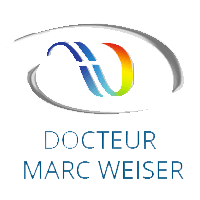Introduction
Presbyopia is defined as the progressive loss of accommodation, the latter being the ability of the human eye to focus on nearby objects. This is an age-related refractive error, usually beginning in one’s forties and stabilizing around 60 years old.
What is accommodation? The “autofocus” role of the crystalline lens enables the accommodation, that is, the automatic focusing of the eye on nearby objects. While reading or engaging in other activities requiring a near vision, the crystalline lens will deform itself owing to the action of the ciliary body, a circumferential muscle tissue to which it is connected by an infinity of small fibrils. These tiny fibers called “zonule” surround the equator of the lens in a 360-degree fashion. Due to its elasticity, the crystalline lens thus deforms itself and increases its refractive power. This allows us to automatically refocus the images on the retina without feeling it, in order to get a clear near vision.
However, when one reaches 45 years old, the elasticity of the lens gradually begins to decrease.
The decreasing and subsequent disappearance of accommodation characterizes presbyopia. It is a complex evolutionary process that is corrected by wearing either half-moon, bifocal or progressive glasses. At the age of presbyopia, only people with moderate myopia may continue to read up close without accommodation, provided they do not wear corrective lenses.
Presbyopia surgical correction has gained major recent improvements. More and more presbyopic patients can benefit from a surgical correction that can now correct distance and near vision.
Two techniques are currently available : presbylasik (excimer laser presbyopia surgical correction) and lens replacement by a multifocal intra ocular lens. Surgical eligibility and choice of the most appropriate are determined after a complete ophthalmologic check-up that will also take in account age, hobbits, concomitant eventual visual refractive errors, and visual requests.
PRESBYLASIK
Presbylasik is the most recent and appropriate technique for young presbyopic patients after 45 years of age. Its purpose is to increase corneal asphericity and create a slight myopic shift on the dominated eye. The addition of both effects allows uncorrected near vision restoration.
Initially dedicated to hyperopic patients, this technique is now also available for myopic patients as well as for those who have a very good distance uncorrected vision.
Creation of a slight myopia on the dominated eye is well tolerated by a vast majority of patients, even though if a couple of months are usually requested to achieve final and perfect tolerance. It is possible and requested, during pre op evaluation, to check and eventually reject any candidate that would not perfectly tolerate such mild myopia. The myopic shift on the dominated eye can be adjusted according to the patient specific requests (computer, reading…), sometimes at the time of a free touch-up which is generally performed a couple of months after the initial procedure.
Two main software programs are currently available, on two different excimer lasers. The LBV® (Laser Blended Vision) software is available on our Carl Zeiss Meditec® MEL 80 excimer laser; it corrects the dominant eye from far to intermediate vision, and the dominated eye from intermediate to near vision. The simultaneous increase in corneal asphericity improves depth of focus as well as binocular comfort. The Supracor® software is available on our Technolas Perfect Vision® Teneo 2 excimer laser; the treatment protocol is quite the same but the difference between both eyes is slighter and compensated by a steepening effect on the center of the cornea which creates some kind of true multifocality on both eyes; various protocols are available (mild, regular, or strong) within various combinations, each of them being dedicated to every single patient.
After surgery patients do not wear any more glasses, except rare and particular circumstances such as night driving and extended fine print reading under poor lightning. Appropriate pre operative patient selection allows extreme satisfaction among the operated patients.
Multifocal intra ocular lenses (IOLs)
Multifocal IOLs are available for patients over 50 years of age, especially the hyperopic ones. They should not be used in myopic eyes before 60 years of age and in special conditions request a retinal surgeon prior advice.
Numerous performing and safe multifocal IOL have been currently available. This variety allows the appropriate IOL choice for each specific patient, depending on his particular requests and needs. Some IOLs are specifically designed for intermediate vision (e.g. computer intensive use), some are dedicated for reading at near vision. Mix and match is an option for bilateral correction, in order to have the best-uncorrected visual acuity in all circumstances and distances.
Overall results are quite excellent and lasting; moderate glare and halos perception are frequently noticed in the post operative period, even though they tend to gradually regress within a couple of months after surgery. Night driving is uncomfortable in only 1 to 2% of operated patients.
The surgical technique is exactly the same as the cataract extraction’s one. Instead of removing an opaque crystalline lens as in cataract surgery, the removed lens is clear in presbyopia correction with multifocal IOLs. Such surgery is therefore an elective surgery whose costs cannot be reimbursed, even partially, by French Social Security system. Only private insurance companies may reimburse this kind of surgery, depending on each specific agreement.
